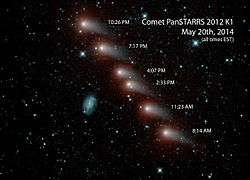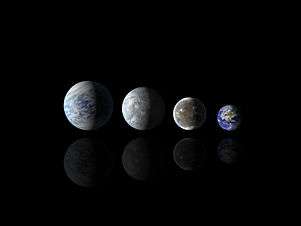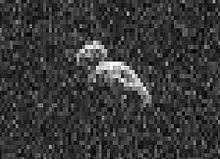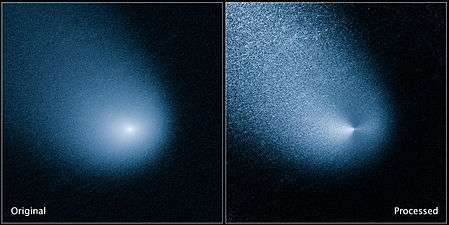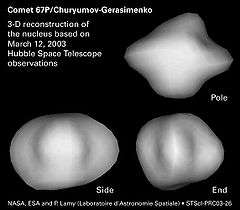C/2012 K1
|
| |
| Discovery | |
|---|---|
| Discovered by |
Pan-STARRS 1.8-m Ritchey-Chretien (F51)[1] |
| Discovery date | 17 May 2012 |
| Orbital characteristics A | |
| Epoch | 11 August 2014[2] |
| Perihelion | 1.0545 AU (q)[2] |
| Eccentricity | 1.00021[2] |
| Orbital period |
several million years inbound (Barycentric solution for epoch 1950)[3] ~700000 yr outbound (Barycentric solution for epoch 2050)[3] |
| Inclination | 142.43°[2] |
| Last perihelion | 27 August 2014[2] |
C/2012 K1 (PANSTARRS) is a retrograde Oort cloud comet discovered at magnitude 19.7, 8.7 AU from the Sun on 17 May 2012 using the Pan-STARRS telescope located near the summit of Haleakalā, on the island of Maui in Hawaii (U.S.).[1]
The comet started 2014 as a northern hemisphere object. By late April 2014 it had brightened to roughly apparent magnitude ~8.8[4] making it a small telescope/binoculars target for experienced observers. In June and July 2014 the comet was near the Sickle of Leo.[5] As of 3 July 2014 the comet had brightened to magnitude 7.9.[6]
From 12 July 2014 until 6 September 2014 it had an elongation less than 30 degrees from the Sun.[4] The comet came to perihelion (closest approach to the Sun) on 27 August 2014 at a distance of 1.05 AU (157,000,000 km; 98,000,000 mi) from the Sun.[2] It crosses the celestial equator on 15 September 2014 becoming a southern hemisphere object.[4]
The comet peaked around magnitude 6.9 in mid-October 2014[7][8] when it had an elongation of around 75 degrees from the Sun.[4] It is visible in binoculars and small telescopes.
References
- 1 2 "MPEC 2012-K36 : COMET C/2012 K1 (PANSTARRS)". IAU Minor Planet Center. 2012-05-21. Retrieved 2013-05-05. (CK12K010)
- 1 2 3 4 5 6 "MPEC 2014-K54: Observations and Orbits of Comets". IAU Minor Planet Center. 2014-05-26. Retrieved 2014-06-15.
- 1 2 Horizons output. "Barycentric Osculating Orbital Elements for Comet C/2012 K1 (PANSTARRS)". Retrieved 2013-05-05. (Solution using the Solar System Barycenter and barycentric coordinates. Select Ephemeris Type:Elements and Center:@0)
- 1 2 3 4 "Elements and Ephemeris for C/2012 K1 (PANSTARRS)". IAU Minor Planet Center. Retrieved 2013-05-05.
- ↑ Bob King (2014-06-11). "Comet PanSTARRS Keeps Getting Better". Sky & Telescope.
- ↑ Seiichi Yoshida (2014-07-20). "Weekly Information about Bright Comets (2014 July 5: North)". Seiichi Yoshida's Comet Catalog. Retrieved 2014-07-23.
- ↑ Yoshida, Seiichi (2014-10-20). "Weekly Information about Bright Comets (2014 Oct. 18: South)". aerith.net. Retrieved 2014-10-21.
- ↑ Seiichi Yoshida (2013-04-29). "C/2012 K1 ( PanSTARRS )". Seiichi Yoshida's Comet Catalog. Retrieved 2013-05-05.
External links
- Get Set For Comet K1 PanSTARRS: A Guide to its Spring Appearance (Universe Today March 17, 2014)
- Comet Pan-STARRS Marches Across the Sky (July 3, 2014)
- C/2012 K1 in the constellation Puppis. Captured 10-23-2014
